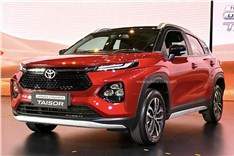Toyota Urban Cruiser Taisor review: This or the Fronx?
Toyota’s newest badge-engineered offering is a compact crossover based on the Fronx.
Published on Jun 03, 2024 04:24:00 PM
32,358 Views
Follow us on

Keep the rear seatbelts fastened as there are no load sensors.

16-inch alloys sport a different design than the Fronx's.

Handy 360-degree camera, but the resolution is poor.
We Like
- Spacious and comfortable
- Enjoyable to drive
We Don't Like
- Ride feels firm at city speeds
- Some key features missing.
Between May 1, 2023 and April 30, 2024, a whopping 44 percent of Toyota’s total sales came from rebadged Maruti products like the Baleno-based Glanza, Grand Vitara-based Hyryder and Ertiga-based Rumion. This model clearly seems to be working for Toyota, and now, there’s a fourth Maruti-based offering, called the Toyota Urban Cruiser Taisor.
Toyota Taisor design
This newest Toyota is a badge-engineered Fronx, which is a handsome car to begin with owing to its crossover-esque stance and coupe-like roofline that exert serious appeal. Furthermore, Toyota designers have done a neat job by seamlessly integrating design elements that firmly link it to other models from the Japanese brand. For example, its DRLs are similar to the Hyryder and the grille, with its honeycomb pattern, is similar to the pre-facelift Innova Crysta. As a result, the Taisor looks like it is a part of the Toyota family when viewed from the front.

Compared to the Fronx, its 16-inch alloys sport a different design, and at the rear, the outer section of the tail-lamps with C-shaped LEDs are new. The connected LEDs on the tailgate are identical to the Fronx, and when you look closely, the LEDs in the tail-lights in the outer and tailgate section don’t seem to match.
Toyota Taisor interior
Unlike the outside, where the Taisor does get an identity of its own, the interiors are bereft of any significant differentiation – they're identical to the Fronx in terms of the design, colour, quality and even fit-finish. But it is still a smart-looking design and the brown-black colours add some vibrancy to the cabin. Ergonomics are spot on – all the controls are easily within reach, and there's plenty of adjustment to find the right driving position. There’s even an adjustable armrest console to get comfortable with.

The Taisor is spacious and its rear bench is comfortable. What’s nice is that there are three individual adjustable headrests and three-point seatbelts too. Sadly, like Maruti, even Toyota doesn’t give load sensors at the back, so even if no one’s here, you’ll need to keep the seatbelts fastened. Otherwise, the rear seatbelt reminder will annoy you for about 90 seconds at the start of every journey.

In terms of equipment, it packs in a heads-up display, auto LED headlamps, cruise control, a 9-inch touchscreen with wireless Apple CarPlay and Android Auto, wireless charging, rear air-con vents and more. It also packs in a useful 360-degree camera, however, its resolution and display quality leaves a lot to be desired. What’s nice, though, is that ESP, hill-start assist and ABS with EBD are standard across the range; side and curtain airbags are reserved for the higher turbo variants.
Toyota Taisor Performance
Like the Fronx, the Toyota Taisor is available with a 1.2-litre petrol engine with a 5-speed manual and automated manual transmission (AMT), and a 1.0-litre turbo-petrol mated to either a 5-speed manual or 6-speed automatic. What’s interesting is that while Toyota commands a slight premium for the 1.2-litre variants over its Maruti counterpart, the turbo variants are priced at par with the Fronx turbo, with the same features list. This strategy seems to have been adopted to push turbo petrol sales in the Taisor, since it contributes less than 10 percent to the Fronx’s sales. And in Toyota’s case, it seems to be working as the turbo accounts for nearly 45 percent of Taisor’s total sales.

Speaking of its 1.0-litre engine, it is one of the nicest small capacity turbo-petrol units in terms of smoothness, performance, linearity, as well as refinement. It feels responsive, revs freely and it spins so eagerly that when you’re driving with verve, the 6,000rpm limiter feels a bit too conservative. There’s a mild-hybrid system too which provides electric boost to this engine when under load, but the difference is negligible and you’ll have to look at the animation on the MID to know when this mild-hybrid system is at work.
The 6-speed torque converter is smooth in its operation. It isn’t an enthusiastic unit per se, as the upshifts are quite slow. However, what driving enthusiasts will appreciate is the fact that this gearbox gives you full control in manual mode; it doesn’t upshift automatically. Also, the paddle shifters respond to inputs rather obediently.

We timed the Toyota Taisor too, and it sprinted from 0-100kph in 11.86 seconds. For reference, the timing is similar to the 120hp Kia Sonet DCT’s 11.94 seconds. However, its rolling acceleration times from 20-80kph and 40-100kph of 6.95 seconds and 8.49 seconds, respectively, are similar to the quickest compact SUV in the market, the 131hp Mahindra XUV 3XO.
At low speeds, the Taisor’s ride quality feels a bit busy due to its stiff suspension setup. On the flipside, it feels stable and confident at triple digit speeds. The steering is light, turning radius is tight and even though it isn’t bristling with feel or feedback, the Taisor feels quite engaging to drive.
Toyota Taisor verdict

With the Taisor, the Japanese brand has opened its showroom to a wider set of buyers, many of whom are first-time Toyota buyers. The Fronx is a fundamentally sorted car to begin with, and the Taisor carries forward these strengths such as its spacious and practical cabin, lengthy equipment list, and its engaging driving manners – turbo-petrol or naturally aspirated petrol, take your pick. Toyota also provides a three-year standard warranty, while its Maruti counterpart provides a two-year warranty, although it is worth mentioning that both offer extended warranty up to the fifth year. Hence, between the Maruti Fronx and Toyota Taisor, the deciding factor is their design and an individual’s brand preference, in terms of sales experience and proximity to a service center. But whichever you pick, these are compact crossovers you can’t go wrong with.
Also see:
Toyota Innova Crysta, Fortuner, Hilux despatches temporarily on hold in India
Toyota Rumion review: Innova's new sibling
Tech Specs 
Copyright (c) Autocar India. All rights reserved.






 Engine
Engine Transmission
Transmission Body
Body Suspension
Suspension Brakes
Brakes Dimensions
Dimensions
Comments
Member Login
Personal Details
No comments yet. Be the first to comment.